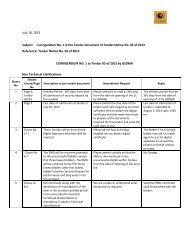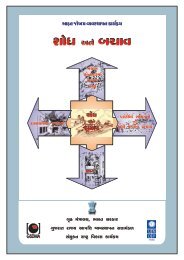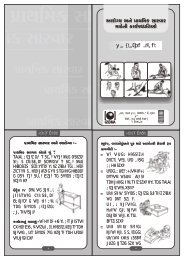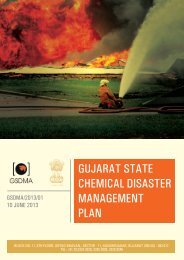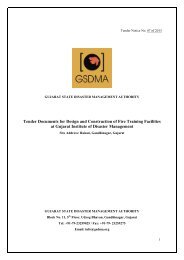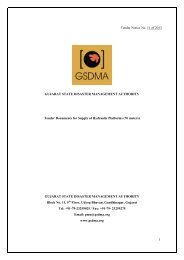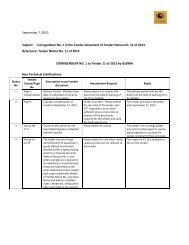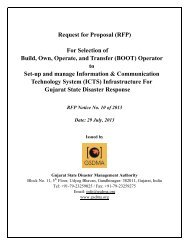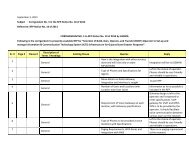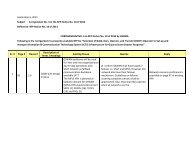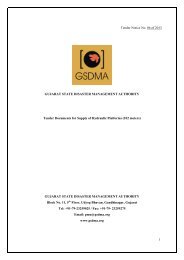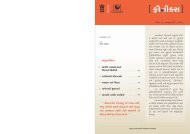Emergency Response Guidebook - Gujarat State Disaster ...
Emergency Response Guidebook - Gujarat State Disaster ...
Emergency Response Guidebook - Gujarat State Disaster ...
You also want an ePaper? Increase the reach of your titles
YUMPU automatically turns print PDFs into web optimized ePapers that Google loves.
GUIDE141Oxidizers - ToxicERG2012ERG2012Oxidizers - ToxicGUIDE141POTENTIAL HAZARDSFIRE OR EXPLOSION• These substances will accelerate burning when involved in a fire.• May explode from heat or contamination.• Some may burn rapidly.• Some will react explosively with hydrocarbons (fuels).• May ignite combustibles (wood, paper, oil, clothing, etc.).• Containers may explode when heated.• Runoff may create fire or explosion hazard.HEALTH• Toxic by ingestion.• Inhalation of dust is toxic.• Fire may produce irritating, corrosive and/or toxic gases.• Contact with substance may cause severe burns to skin and eyes.• Runoff from fire control or dilution water may cause pollution.PUBLIC SAFETY• CALL EMERGENCY RESPONSE Telephone Number on Shipping Paper first. If Shipping Paper notavailable or no answer, refer to appropriate telephone number listed on the inside back cover.• As an immediate precautionary measure, isolate spill or leak area in all directions for at least 50meters (150 feet) for liquids and at least 25 meters (75 feet) for solids.• Keep unauthorized personnel away.• Stay upwind.• Keep out of low areas.• Ventilate closed spaces before entering.PROTECTIVE CLOTHING• Wear positive pressure self-contained breathing apparatus (SCBA).• Wear chemical protective clothing that is specifically recommended by the manufacturer. It mayprovide little or no thermal protection.• Structural firefighters’ protective clothing will only provide limited protection.EVACUATIONLarge Spill• Consider initial downwind evacuation for at least 100 meters (330 feet).Fire• If tank, rail car or tank truck is involved in a fire, ISOLATE for 800 meters (1/2 mile) in all directions;also, consider initial evacuation for 800 meters (1/2 mile) in all directions.EMERGENCY RESPONSEFIRESmall Fire• Use water. Do not use dry chemicals or foams. CO 2 or Halon® may provide limited control.Large Fire• Flood fire area with water from a distance.• Do not move cargo or vehicle if cargo has been exposed to heat.• Move containers from fire area if you can do it without risk.Fire involving Tanks or Car/Trailer Loads• Fight fire from maximum distance or use unmanned hose holders or monitor nozzles.• Cool containers with flooding quantities of water until well after fire is out.• ALWAYS stay away from tanks engulfed in fire.• For massive fire, use unmanned hose holders or monitor nozzles; if this is impossible, withdraw fromarea and let fire burn.SPILL OR LEAK• Keep combustibles (wood, paper, oil, etc.) away from spilled material.• Do not touch damaged containers or spilled material unless wearing appropriate protective clothing.• Stop leak if you can do it without risk.Small Dry Spill• With clean shovel place material into clean, dry container and cover loosely; move containers fromspill area.Large Spill• Dike far ahead of spill for later disposal.FIRST AID• Move victim to fresh air.• Call 108 or emergency medical service.• Give artificial respiration if victim is not breathing.• Administer oxygen if breathing is difficult.• Remove and isolate contaminated clothing and shoes.• Contaminated clothing may be a fire risk when dry.• In case of contact with substance, immediately flush skin or eyes with running water for at least 20minutes.• Keep victim warm and quiet.• Ensure that medical personnel are aware of the material(s) involved and take precautions to protectthemselves.Page 222Page 223



